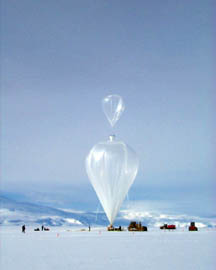Imagine the Universe News - 1 March 2001
Classy Antarctic Balloon Captures the Earliest Light of the Universe
| 01 March 2001 |
McMurdo Station, Antarctica -- If you think penguins in Antarctica look classy in their tuxedos, you should see our scientific balloon wearing a top hat.
 TopHat Launch Click for larger image. |
TopHat, an innovative hat-shaped astronomy experiment that sits on top of a balloon, circled around the frozen continent at 120,000 feet for nearly two weeks in January, collecting light from the cosmic microwave background radiation.
The flight was a success, and TopHat scientists are now back in the relative warmth of the United States, beginning the year long process of analyzing the data.
Observing the microwave background, formed about 300,000 years after the big bang, enables scientists to understand the nature of our Universe when it was an infant. The radiation comes from an era before the creation of stars and galaxies. The Universe is now about 10 to 15 billion years old.
"It is remarkable that we can determine so much with such data," said Stephan Meyer, a TopHat scientist at the University of Chicago. "For instance, we can measure the mass of the Universe to about 10 percent accuracy. The data will also help to establish whether the Universe will expand forever, or eventually collapse upon itself."
TopHat measures the clumpiness of matter when the Universe was very young. This is seen as slight intensity differences in the cosmic microwave background radiation. By comparing the clumpiness of the Universe back then with what we observe today, we can test various theories of how this change, or "evolution", takes place.
Last year, two microwave balloon experiments (MAXIMA and BOOMERANG) determined that the Universe is geometrically flat, that is, obeys Euclidean geometry. The experiments also found that the Universe will expand forever and that it comprises about 5 percent ordinary matter we can see, 30 percent dark matter of an unknown nature, and 65 percent dark energy, a mysterious force that is accelerating the expansion rate of the Universe.
The MAXIMA and BOOMERANG results are not in total agreement, though. Also, much of this information comes from the larger scale clumpiness (about the size of the Moon or Sun in the sky) that is seen in that data.
TopHat looked at this size of clumpiness, as well as things that are down to half this size, with greater accuracy. TopHat data should provide a powerful way to tell which of several explanations of the current data are correct.
The TopHat experiment included a spinning telescope and a detector system. It mapped a 48-degree diameter disk of the sky above the Southern Polar Cap. The telescope simply spun at a constant rate about its vertical axis. As the Earth rotated, this entire cap was observed each day. There was a payload at the bottom of the balloon as well, in the traditional location. This bottom payload provided the power and computer support for the top payload, which was restricted in weight because of its position.
"This is the first time we have ever attempted to fly a complex payload on the top of a balloon," said Edward Cheng, TopHat Principal Investigator at NASA Goddard Space Flight Center in Greenbelt, MD. "This unique vantage point allowed the payload an unobstructed view of the entire sky, and it minimized the worry of stray emission and reflected Earth light from the balloon and the structure supporting the bottom payload."
TopHat required two balloons for launching. A smaller balloon lifted the top payload from above until the larger, main balloon was strong enough to support its 200-pound mass from beneath. The smaller balloon was detached before the main balloon was released. After release, the balloon picked up the bottom payload as it rose.
TopHat took six years to design and build, a collaboration consisting of NASA's Goddard Space Flight Center, the University of Chicago, University of Wisconsin, and the Danish Space Research institute.
TopHat won't fly again. The hardware is still in Antarctica, waiting retrieval. In June, NASA will launch the much-anticipated Microwave Anisotropy Probe (MAP). This satellite will measure the cosmic microwave background from space with unprecedented accuracy. TopHat's data will serve as a roadmap for certain MAP measurements.
For more information about the cosmic microwave background and TopHat -- including swell images, videos and tales from Antarctica -- refer to http://topweb.gsfc.nasa.gov.

